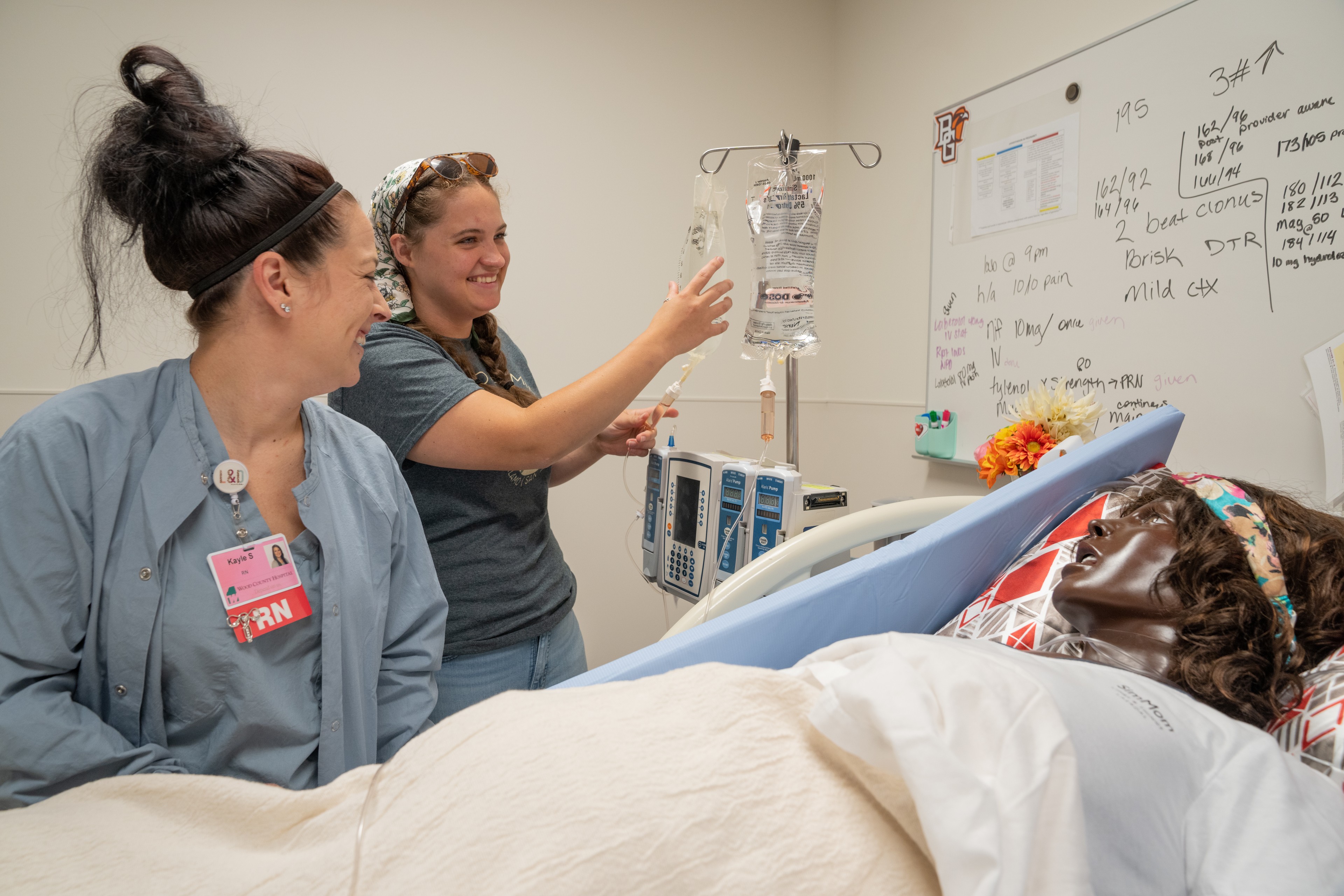
BGSU collaborates with local healthcare partners to offer critical maternal complications training
BGSU Nursing program provides simulation lab sessions to help nurses recognize early signs of preeclampsia and postpartum hemorrhage
By: Nick Piotrowicz
For pregnant patients demonstrating signs of preeclampsia or postpartum hemorrhage, early detection can be the difference between life and death.
Though the rates of both complications are low, overall rates of maternal mortality more than doubled in the U.S. between 1999-2019, according to a 2023 study published in the Journal of the American Medical Association.
To help local nurses act quickly before tragedy strikes, the Bowling Green State University School of Nursing used its simulation lab to offer two training sessions with a specialized manakin – the "SimMom" – that allows nurses to gain critical hands-on experience in a controlled environment.

In tandem with its local healthcare partners from Vantage Healthcare of Ohio – which includes Wood County Hospital, the Bellevue Hospital, Fulton County Health Center, and Community Health and Wellness Center of Bryan, Ohio – the School of Nursing at BGSU provided four hours of continuing education sessions to aid nurses in recognizing the two complications early, when action is most critical.
“We hope that nurses never see these complications, but they happen to women from all socioeconomic and ethnic backgrounds,” said Lisa Jacobs, an assistant professor and the simulation coordinator in the BGSU School of Nursing.
“We as nurses have to learn how to recognize those symptoms and recognize them as early as possible. You want to have good outcomes for both mom and baby, so you have to take action quickly following current evidence-based practice.”
The two conditions are both among the top five causes of pregnancy-related death, according to Ohio Department of Health data, but the majority of them are classified as preventable.

Jacobs, who led sessions along with BGSU Assistant Clinical Professor Kathryn Hebert-Rodriguez, said additional education and familiarity with protocols on preeclampsia and postpartum hemorrhage can help improve outcomes for mothers and babies.
Preeclampsia, or high blood pressure during pregnancy, and postpartum hemorrhage, severe bleeding after birth, often include symptoms that are common to pregnancy.
A preeclamptic patient might not register headaches, gastric issues or shortness of breath as unusual before a routine checkup detects high blood pressure – but grouped together, the symptoms could be a warning sign of danger ahead.
The SimMom, which can do everything from breathe to conduct a live birth, simulated a patient in the early stages of complications, allowing nurses to experience the proper ways to intervene.
“Our goal is that nurses ask those critical questions: Do you have a headache? Are you nauseous or having any gastric concerns?” Jacobs said. “Those things are common in pregnancy, but combined with an elevated blood pressure and some other pieces should heighten our awareness that we could be dealing with a complication.

“There are layers of learning happening. They’re in a situation where the mother is deteriorating rapidly and the nurses need to use clinical judgement in assessing the patient and escalating their care needs to a simulation physician to improve outcomes.”
After undergoing the high-fidelity simulation, the training sessions moved into a debriefing in which nurses had the opportunity to discuss and reflect upon the process and protocols involved in aiding a patient experiencing complications.
By collaborating with local healthcare partners, Jacobs said the sessions provided obstetric nurses with critical experience that can prepare them to help patients avoid the worst when they experience the real thing, and also benefit current BGSU students preparing for maternal simulations.
“So often, these are high-stress, low-frequency events, and as healthcare workers, that’s a huge challenge for us,” Jacobs said. “It doesn’t happen very often and the risk of poor outcomes is very high, so if we can practice in a safe setting that helps them to recognize those things, we’re doing a service for our school and our community.”

Related Stories
Media Contact | Michael Bratton | mbratto@bgsu.edu | 419-372-6349
Updated: 07/24/2023 10:17AM



